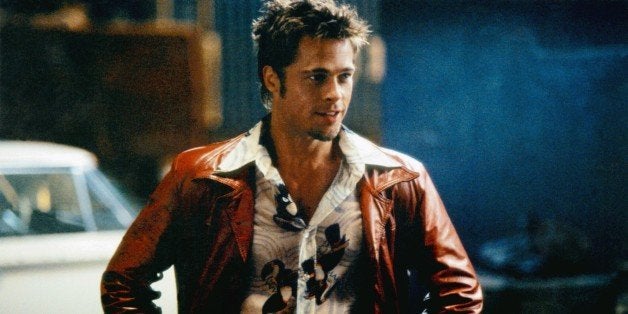
A major year for cinema, 1999 challenged movie audiences with rich, thought-provoking, psychological storytelling. It was the year of "Magnolia," "Eyes Wide Shut," "Being John Malkovich," "The Matrix" and "The Sixth Sense." But there was one film that forever changed the way audiences approached the relationship between illusion and reality onscreen: David Fincher's "Fight Club."
Released on Oct. 15, 1999, the film adaptation of Chuck Palahniuk's novel helped reintroduce the possibility that movies can exist as fantasy inside a character's mind. (In this case, Edward Norton's unnamed character -- the Narrator or "Jack" -- who realizes his manifestation of Tyler Durden, played by Brad Pitt, was not part of reality.) "Fight Club" not only impacted culture by spawning real-life versions of the exclusive organization at its center, but made audiences question what they saw onscreen to a major extent.

Because it is only after we've lost everything that we're free to do anything, we're breaking the first two rules of "Fight Club" to discuss the wild fan theories the film has since engendered. Now, listen to the Chemical Brothers' soundtrack while you let your mind go:
1. The "Calvin and Hobbes" Theory
What if Norton's unnamed character is actually Calvin of "Calvin and Hobbes," and Tyler is his imaginary tiger?
Galvin P. Chow first introduced an extensive theory that mapped out how "Ed Norton is playing the part of grown-up Calvin," and it's pretty mind-blowing. It begins with the classic comic book, in which Calvin creates an imaginary friend out of his stuffed animal, but by the time he reaches seventh grade, the boy is forced to face reality and "un-imagine" Hobbes. Calvin grows up and attempts to forget his best friend, but the pain and bitterness of it turn him into the miserable, insomnia-afflicted Narrator. Years later, Hobbes evolves into Tyler, since, at the Narrator's age, he would no longer accept an anthropomorphized jungle animal.
Still not sold on the theory? If you trace "Fight Club" back even further, you'll find roots of the secret mens-only organization in Calvin and Hobbes' G.R.O.S.S. (Get Rid of Slimy girlS), the exclusive boys-only club they made when he was young. Did we mention that at the beginning of G.R.O.S.S. meetings, as Hobbes read aloud the minutes from the previous meeting (hm, Tyler led meetings, too) that there were fights between members? Sold.
2. The "Calvin and Hobbes"/"Dark Knight" Theory

Because one theory is never enough, a Reddit user took the previous "Calvin and Hobbes" theory even deeper down the rabbit hole and applied it to "The Dark Knight." If Calvin grew up to become the Narrator, what if, when the Narrator shot himself to kill Tyler, his imaginary friend actually took over and turned Calvin/Narrator into the Joker?
Okay, bear with us: If Calvin/the Narrator evolved into the personality of Tyler, then his penchant for explosives, anarchy and mayhem would continue to build since his more passive identity is no longer present to hold himself back. Take these five main connections between Norton's Narrator-cum-Tyler and the Joker (Heath Ledger) in Christopher Nolan's "Dark Knight," as explained by a Reddit user:
- A) Both have sizable armies of disposable minions.
- B) Both are, in some manner, [unstable].
- C) Both have a tendency toward and aptitude for rigging explosions.
- D) Both have [facial scarring].
- E) Both are predisposed towards all things “anarchy.”
Let's also not forget that both the Joker and Tyler (and thus the Narrator) had troubled relationships with their fathers.
3. The Imaginary Marla Singer Theory

We all know Tyler is a figment of the Narrator's imagination, but what if Marla is too?
One of the ways we know that Tyler isn't real in the movie is that he is never addressed by anyone else singularly without the Narrator present. The same goes for Marla, as no one acknowledges her directly, with a few minor exceptions (the waiter in the restaurant, Project Mayhem henchmen in the tower, etc.).
In an essay, one writer argues this case claiming that Marla is merely the female counterpart to Tyler for the Narrator -- the representational mother to his projection of a father-figure -- and the personification of the Narrator's guilt and pain. Her purpose in the film is to "balance and counter the animal that is Pitt's character," as the author put it. If Marla is also a figment of Norton's imagination, then this furthers the larger theory that everything we see in "Fight Club" is an illusion of the main character's mind, including the ending when the buildings collapse. Do you buy it?
4. The "Ferris Bueller" Theory

To understand this theory you first have to be familiar with the "Fight Club"-inspired "Ferris Bueller" theory, which proposes the possibility that, like Tyler, Ferris was a figment of Cameron's imagination. In SlashFilm's description of this theory, which made the rounds in 2009, Cameron's adventures with Ferris and Sloane around Chicago "are all just played out in his head" as he lies sick in bed.
Now take that theory, and circle it back to "Fight Club," as Reddit user tl34tf did. In this wild theory, "Ferris Bueller's Day Off" actually serves as the prequel to "Fight Club," in which Norton's Narrator is simply Cameron all grown up, making up a new imaginary friend. Here's the theory in full:
In high school, Cameron fell into a malaise, brought on by an overbearing father, and created his alter ego Ferris to break him out of it. Ferris ceases to exist when he leaves Cameron after crashing the Ferrari. Later, when Cameron's father finds the state of the Ferrari, he has a fatal heart attack. Stunned from the result of his actions, Cameron vows to never act out of line again. He establishes a career in investigating car crashes, and leads as boring an existence as he can, until his subconscious creates an even more powerful alter ego, Tyler Durden.
It's definitely a stretch, but still a fun one to consider. Ferris and Tyler are both the idealized versions of the men Cameron and the Narrator want to be, respectively.
5. The Tyler Actually Exists Theory

The whole basis of "Fight Club" is that Tyler isn't real. But what if he is?
One blogger, D.F. Lovett, believes that Tyler actually exists and had planned the Narrator's eventual breakdown from the start, manipulating his fragile mental state.
When Tyler met the Narrator on the plane, he realized that he could take advantage of the his loneliness and befriend him. Thus, according to Lovett's theory, Tyler began making rules for the Narrator, telling everyone in Project Mayhem that Norton's character was really the mastermind and leader, when in fact they all knew it was the real, flesh-and-blood Tyler. This led to the Narrator's erratic and heightened behavior, so that when Pitt's character eventually left him, the Narrator began hallucinating and imagining a version of the real Tyler at the end.
Is "Fight Club" about a man who invents an illusion of his idealized self, or about "a soap-peddling con artist [who] tricks a lonely insomniac into taking the fall as the mastermind of a terrorist organization"?
Bonus: The "Harry Potter" Theory
Okay, totally kidding. But then again, maybe not ...
